#Jewish Heritage Restoration
Explore tagged Tumblr posts
Text
Don't let polish authorities protect Netanyahu
Quick context:
a petition you can sign to let them know you object:
Petition text in English:
Poland, December 2024
Open letter: an appeal for equal standards in the application of international law, addressed to the Prime Minister, the Council of Ministers of the Republic of Poland, the Minister of Foreign Affairs and the Minister of Justice
We, for whom the memory of the Holocaust is an ethical challenge, contained in the slogan "never again - for anyone, anywhere", we, who for a year have been watching with horror the massacre committed by Israel on Palestinian women and men in the Gaza Strip, attacks on residents of the West Bank, the bombing of civilians in Lebanon, we, who follow reports of inhumane torture in Israeli prisons, the killing of Palestinian journalists, healthcare workers and the UN, and Israel's blocking of humanitarian aid sent to Gaza, we, who for over a year have been watching with horror and anger the first-ever live coverage of genocide, the perpetrators of which publicly boast about their intentions and actions, we accept with hope the arrest warrant for Benjamin Netanyahu and Yoav Galant issued by the International Criminal Court. As human rights organizations have been emphasizing for years, bringing perpetrators of human rights violations to justice is one of the most important tools for restoring justice. The international community is responsible for ensuring that perpetrators learn that they are not above the law.
Therefore, we call on the government of Poland, a state that signed the Rome Statute establishing the International Criminal Court, to unequivocally declare that it will comply with the decision of the ICC and join the prosecution of those suspected of committing war crimes indicated by it. This is required by basic solidarity with the Palestinians. This is required by basic respect for human life, every life. This is what we expect from the Polish government, we citizens and residents of Poland, showing solidarity and compassion for those suffering.
At the same time, we want to emphasize that we consider identifying criticism of the criminal policies of the state of Israel with anti-Semitism to be absurd and immoral, as well as dangerous to the Jewish culture and tradition that many of us hold dear. We do not agree to reducing this culture and tradition to the policies of one state, repeatedly condemned by international organizations, human rights organizations and part of Israeli society. This would mean the squandering of Jewish heritage, about which Marek Edelman, the leader of the Warsaw Ghetto Uprising and a doctor in Poland after the war, used to say that being a Jew means being on the side of the beaten and wronged. We also refuse to listen to the arguments of those who try to convince us that the power occupying, displacing and dispossessing Palestinians is a weaker party than the occupied population of the West Bank and those imprisoned and besieged in Gaza for almost two decades. We call on Israel to immediately ceasefire and hold those guilty of massacres and war crimes accountable. We call on the Polish government to comply with the ICC ruling.
We assure Palestinian sisters and brothers of our solidarity and express our dreams of freedom and peace for Palestine, freedom and peace for the whole world!
#signal boost#free palestine#palestine#free gaza#poland#polska#i am so so so disappointed and appalled
154 notes
·
View notes
Text

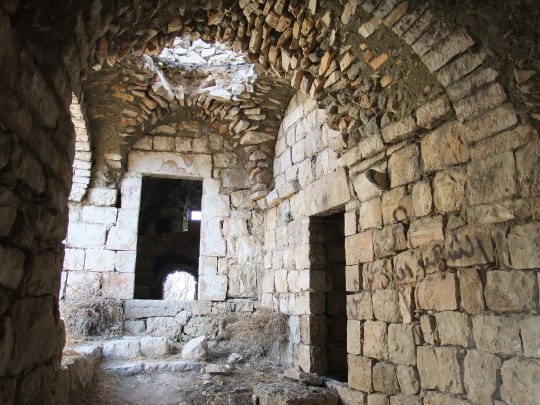
when the homes in the depopulated palestinian village of lifta were originally built is impossible to tell and most likely varies from house to house. the area's been known since ancient times, including having been written about in the hebrew bible. it's retained multiple different names throughout history - lifta by romans, nephto by byzantines, clepsta by crusaders, then lifta again by arabs. in more recent times, the area saw battle in the early 19th century, when it saw a peasant's revolt against egyptian conscription and taxation policies. (egyptian-ottoman ruler muhammad ali had attempted to become independent from the ottoman empire, and sought to use the area of "greater syria" which palestine was apart of as a buffer state.)
the village was predominantly muslim with a mosque, a maqām for local sage shaykh badr, a few shops, a social club, two coffee houses, and an elementary school which opened in 1945. its economy was based in farming - being a village of jerusalem, farmers would sell their produce in the city's markets. an olive press which remains in the village gives evidence to one of the most important crops its residents farmed. the historically wealthy village was known for its intricate embroidery and sewing, particularly of thob ghabani bridal dresses, which attracted buyers from across the levant.
lifta also represents one of the few palestinian villages in which the structures weren't totally or mostly decimated during the 1948 nakba. 60 of the 450 original houses remain intact. from zochrot's entry on lifta:

israel's absentee property law of 1950 permits the state to expropriate land and assets left behind, and denies palestinians the right to return to old homes or to reclaim their property. it's estimated that there's around 400,000 descendants of the village's original refugee population dispersed in east jerusalem, the west bank, jordan, and the palestinian diaspora.
like many depopulated palestinian houses, some of those in lifta were initially used to settle predominantly mizrahi immigrants and refugees, in this case 300 jewish families from yemen and kurdistan. the houses weren't registered in their names, and the area generally saw poor infrastructure and no resources including water and electricity provided by the government. most left in the early 1970s as a part of a compensation program to move out people who'd been settled in depopulated palestinian houses - if they didn't, they were referred to as "squatters" and evicted. (holes were even drilled in the roofs of evacuated buildings to make them less habitable). the 13 families which remain there today only managed to do so because they lived close to the edge of the village.
in 1987, the israeli nature reserves authority planned to restore the "long-abandoned village" and turn it into a natural history center which would "stress the jewish roots of the site", but nothing came of it. several more government proposals on what to do with the land had been brought up since then. this culminated in in 2021 when the israel land administration announced without informing the jerusalem municipal authorities that it issued a tender for the construction of a luxury neighborhood on the village's ruins, consisting of 259 villas, a hotel, and a mall. since 2023, they've agreed to shelve and "rethink" these plans after widespread objection.
the reasons for the objections varied significantly between the opposing israeli politicians - who see the village as an exemplar of cultural heritage and "frozen in time" model of palestinian villages before 1948 - and palestinians - who largely see the village as a witness of the nakba and a symbol of hope for their return. lifta is currently listed by unesco as a potential world heritage site, a designation netanyahu has threatened to remove several times.
many palestinians who are descendent from its former residents still live nearby. like with many other depopulated palestinian villages, they've never ceased to visit, organize tours of the village, and advocate for its preservation.
#palestine#info#nakba#my posts#the dresses link isnt specific to lifta thobs but provides a good overview#i couldn't find anything online abt lifta's embroidery but some of the book pdfs on palestinian costume i reblogged a while ago have info
415 notes
·
View notes
Text
In light of recent events and my brother having a talk in sacrament tomorrow, I was reminded of a talk that I gave last year that focused on diversity and I thought y’all might appreciate it.
There is a story Jesus told about a Jewish man who was severely injured and left on the side of a road. Various travelers saw him and ignored him, including a Jewish priest. Although the injured man was of the same creed as the priest, the priest continued on his way with no regard for his fellow man. Eventually, a Samaritan man walked by. Now, Samaritans and Jews detested one another. The Samaritan’s preexisting bias would dictate that he, upon seeing the man was a Jew, ignore him as the previous travelers had. However, the Samaritan saw the man suffering and decided to help him no matter their personal and cultural differences. The Samaritan did what the other travelers chose not to and demonstrated true caring for one’s neighbors without regard for bias. The parable of the good Samaritan provides a valuable example for us. Would you take time out of your day to help someone in need, even if they belonged to a group of people whom you dislike or disapprove of? Are you willing to sacrifice your prejudice in an effort to help people belong in the church?
Our Heavenly Father loves diversity. When he created the earth, He did not make everything uniform and identical. He made millions of distinctive and unique species, plants, and other incredible creations. From seahorses to raccoons to peregrine falcons, the creatures on this earth are each special. The same goes for people. The assorted characteristics that differentiate us also make us human. Some of us are short, some of us are gay, some like reading, and others can wiggle their ears. God doesn’t love us in spite of our diversity, but because of it. He loves diversity. If he didn’t, he wouldn’t have made each one of us one-of-a-kind. He wants all of us to belong and to appreciate that which makes us special, just as He does.
Even within the church there is exceptional diversity. In the talk that I am referencing, The Doctrine of Belonging, Elder D. Todd Christofferson says quote “As the long prophesied latter-day gathering of the Lord’s covenant people gains momentum, the Church will truly be composed of members from every nation, kindred, tongue, and people.” When the church was restored, the first members were all white and of European heritage. But diversity is the natural result of having a widespread group, and as the church became more vast, so did the diversity within it. There are millions of members in this church that are of varying colors, backgrounds, genders, and sexualities. There are members who speak languages from the obscure to the well-known. There are members who have medical and mental health problems and members who speak with a stutter or a lisp. Our differences don’t make us less of God’s children, but some among us will belittle and alienate members who are unlike them. God invites all of his children and all of their diversity to partake in his covenants and return to him. We should follow in His example by loving diversity and striving to make everyone know that they belong in our Savior’s church.
Helping people feel and know that they belong in the church requires everyone to let go of their preconceived notions, judgments, and biases. Each and every one of us has prejudices. We discriminate based on serious things such aswhether or not a person has gone to prison or who someone voted for in an election, and we discriminate based on simple things like what music someone listens to or what type of clothes someone wears. Prejudice is often nothing more than a sweeping generalization that misrepresents a group of people. Within church culture, prejudice is unfortunately common and it is counterproductive to helping people feel like they belong in the kingdom of God. The general handbook for the church states, “Prejudice is not consistent with the revealed word of God. Favor or disfavor with God depends on devotion to Him and His commandments, not on the color of a person’s skin or other attributes. The Church calls on all people to abandon attitudes and actions of prejudice toward any group or individual.” When we are prejudiced against a person, we have a mental block that prevents us from helping that child of God feel like they belong. Prejudice gives way to unjustified judgment, which in turn can lead to members of the church feeling out of place in the one setting where they should feel completely at ease.
Everyone in this room, including myself, judges people. We judge people for how they dress when they attend church, how many children they have, how short or long their hair is, or how eloquently they speak, among other things. We may keep our judgment to ourselves, speak it behind someone’s back, or even tell it to their face. Elder Christofferson remarked on this, saying, quote “We may unwittingly impose expectations on others – or even ourselves – that are not the Lord’s expectations. We may communicate in subtle ways that the worth of a soul is based on certain achievements or callings”. In what subtle – or not so subtle- ways do you convey your judgments? When someone who does something you disapprove of walks into a room do you turn your body away from them and avoid including them?
As often as we may cast judgment upon others, it is not our place to do so. Judging our brothers and sisters both within these walls and outside them only splits the kingdom of God. We all sin and we all sin differently. There is a saying: Don’t judge others because they choose to sin differently than you do. Who are we to judge the sins of others? Just because we have opinions on proper etiquette, behavior, and beliefs it doesn’t mean that it is our place to enforce them. They remain opinions only. We will not always know all the details about a situation. We don’t know the circumstances surrounding why a couple has no children. We don’t know if the brother who doesn’t make eye contact has autism or another disorder that makes eye contact difficult. We don’t know what may have happened behind closed doors before a divorce. We don’t know if the sister who uses her phone during class needs to use it to be able to focus. Judging our neighbors can, and frequently does, drive our beloved brothers and sisters away from the church, whereas loving our neighbors as Jesus loves us will help them to know that they belong here with us.
Elder Christofferson also stated, quote, “It is a sad irony when someone, feeling he or she doesn’t meet the ideal in all aspects of life, concludes that he or she doesn’t belong in the very organization designed by God to help us progress toward the ideal”. Perfection does not happen in this life, and yet in church culture we often make it seem as if perfection is a prerequisite for salvation.Such an unreasonable expectation creates an unnecessary divide in the church. We do not have to do certain things to belong in this church. Every single person on this earth belongs in Heavenly Father’s kingdom, no matter their past sins, current situations, and future mistakes.
There are things that people believe are “required” to be a worthy disciple. Regarding the passing of the sacrament, some hold the belief that every young man must be clean shaven, devoid of jewlery, have short hair, and wear a white shirt and tie. The Lord, however has made it a simple act of reverence and service, with the only requirement being that, “Those who administer the sacrament should be well groomed and clean. They should not wear clothing or jewelry that might detract from the worship and covenant making that are the purpose of the sacrament.” This is an example of a church culture misconception and is only one of many others which are geared towards being perfect in this life. Every worthy and able young man has been asked to prepare for and serve a mission. However, serving a mission is not a requirement to hold the priesthood and to serve the Lord throughout their lives. We have been given free agency, and it is not our place to judge when an individual chooses not to serve a mission or when a missionary returns home early. Some members cannot fathom saying no to a calling even if they know that their personal circumstances would clearly be incompatible with the calling at that time. How are our sisters and brothers within the church supposed to know that they belong when we make them feel like they have to be this picture-perfect human being?
If we want to gather Israel, we cannot only minister to those whom we feel comfortable with. Our baptismal covenants did not say to “Bear our friends’ burdens and only our friends' burdens; mourn with only those whom we feel comfortable with; comfort only those whom we like.” They said to, “bear other’s burdens, that they may be light, mourn with those that mourn; and comfort those in need of comfort.” The language in our baptismal covenants does not exclude any of God’s children, so why do we?
When you see someone who doesn’t seem to be included, make a point to talk to them. If a brother or sister stops attending church, reach out to them. Show those around you that they belong, even if it means that you have to step out of your comfort zone. Don’t be afraid to be a voice for others when there’s an untoward joke or when someone is being talked about behind their back. Love those in need of love, even those nobody spares a glance for. Be like our Savior in all that you do, and you will show those around you how much they belong.
20 notes
·
View notes
Note
Have you heard about The Little Synagogue on the Prairie? I went to Heritage Park in Calgary last weekend and I was able to see it, it’s a really fascinating part of history and it’s been restored beautifully. The Torah scrolls there were donated by the local Jewish community and they’ve been able to trace the scrolls back to a specific calligrapher in Prague 200 years ago. The person doing the historical interpretation there was Jewish and she was able to tell me a lot about the history and I think it’s really neat that it’s highlighted in the museum like that so more people can learn about it. They have some beautiful antique menorahs there too.
I had heard about them, yeah! :) That's awesome.
40 notes
·
View notes
Photo

Angels in Christianity
Angels in Christianity act as messengers of God, bring good news, and help believers. Their role developed from the function of angels in ancient Judaism but continued to evolve as Christianity became a separate religion.
The Last Judgement by Giotto
Giotto di Bondone (Public Domain)
Jewish & Zoroastrian Origins
What became the independent religion of Christianity emerged in the 1st century CE from the teachings of a Jewish apocalyptic movement based upon the ministry of an itinerant Jewish preacher, Jesus of Nazareth. The prophets of Israel had predicted that God would raise up a messiah ("anointed one") from the line of King David, who would help to usher in God's final intervention in history, the eschaton, the final days. This was to be God's kingdom on earth, to restore the nation of Israel from its oppressors. The result would be a new Eden, God's original plan for humans. Jesus' appearance is described in Mark's gospel: "The time is fulfilled, and the kingdom of God has come near; repent and believe in the good news" (Mark 1:15).
However, various groups of Jews had different views on the nature of the messiah. The Hebrew, "anointed one" in the earliest texts was from the story of the prophet Samuel choosing David as king by literally pouring oil on his head. Others had a more esoteric concept of a divine being.
The Achaemenid Empire ruled the Middle East, which included Israel, until Alexander the Great (r. 336-323 BCE) conquered the region. The state cult of Zoroastrianism influenced concepts in Judaism. The original Persian creator god, Ahura Mazda, a being of pure good, emanated the spenta mainyu (creative spirit/mentality) in pairs of males and females who procreated. These beings created both the physical universe and humans. At the opposite end of the polarity of Ahura Mazda was druj, chaos, disorder, personified as Ahriman.
The spenta mainyu were often referred to with the term yazata to distinguish them from the agents of Ahriman. Yazata was Persian for a being "worthy of worship through song and sacrifices." This gave rise to the oppositional polarity of good against evil (angels and demons), with constant battles between the two forces. In ancient Judaism, only the God of Israel could receive sacrifices, but angels could be petitioned through hymns and prayers for benefits. The idea that humans had a "guardian angel" arose from Zoroastrianism.
Eschatology (the study of events in the final days, from the Greek eschaton) was the idea in Zoroastrianism that ultimately the good creator god Ahura Mazda would rescue all the good people in a final conflagration that would end the world as we know it. He would send the saoshyant, "one who brings benefits" to restore all the good souls. The living and the dead would be reunited and live in peace and harmony. Like the angels, the saoshyant was worthy of worship. This saoshyant figure was understood by some as a pre-existent, divine messiah.
To affirm that Jesus literally came from the line of David, Christians turned to Psalm 2, in ancient context a psalm about David as the first king:
I will tell of the decree of the Lord: He said to me, "You are my son; today I have begotten you. Ask of me, and I will make the nations your heritage and the ends of the earth your possession." You shall break them with a rod of iron and dash them in pieces like a potter's vessel. (Psalm 2:7-9)
However, the term "sons of God" appears for the first time in Genesis, and it refers to the angels. From the beginning, the movement around Jesus was faced with the problem that angels were immortal, but Jesus died by crucifixion. A dead messiah was not much help to the Jews. A resolution was found in an early claim that Jesus was resurrected from the dead and then exalted to heaven to share God's throne.
Anastasis Scene in Chora Museum
Hagia Sophia Research Team (CC BY-NC-SA)
Continue reading...
17 notes
·
View notes
Note
just say you hate jews and go, nazi.
okay guys, let's talk about israel from a jewish perspective. because that's what I am. jewish.
let's start with a simple fact: a lot of israelis i know about aren't actually jewish. this is extremely anecdotal but still worth to point out. I know that in the beginning of the Ukranian war a lot of russians (non jews) have used fake family trees, agencies that fake ur jewish heritage, and some have reportedly used jewish memorabilia that their ancestors have taken away during pogromy or holocaust from jewish people. thats pretty fucked up isn't it? but u guys don't care about those jews, the ones killed in the actual genocides like holocaust or holodomor or pogromy, because u guys don't actually care about jewish people. u guys just need yet another whataboutism. if u guys cared so much about jewish people, u would be more invested in restoring back synagogues destroyed during ww2, into restoring communities and helping families find each other. but u guys only care about israel really, which says a lot about YOUR view on jewish people.
and to finish it off, the orthodox sect of judaism i was raised in, yeah I'm an orthodox jew, just does not believe in returning to the promise land until the messiah comes down to our synagogue (which was destroyed and never restored btw) to guide us. so to put it plainly, all of israelis right now are just heretics to me and I don't want a single goy up in my business, nor do I want another jewish person up in my business, because how can u argue about "religious" meaning of israel to jewish people and then disregard my and my sects beliefs just because it's not convinient?
and to end it off, my family and my jewish ancestors have been through a lot because of antisemites, but that is what makes me stand with Palestine today. we felt the hatred of ethnic cleansing, we felt the taste of genocide, and that's why I stand with Palestine.
From the river to the sea, Palestine will be free! 🇵🇸
#palestine#stand with palestine#from the river to the sea palestine will be free#israel is an apartheid state#israel is a terrorist state#asks
45 notes
·
View notes
Text
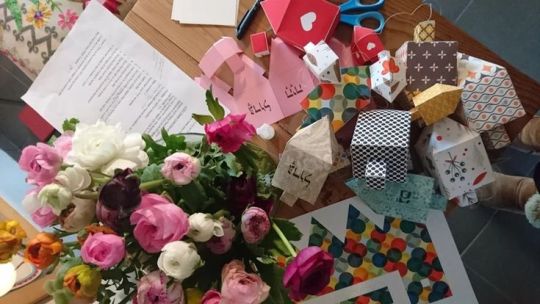









I wish to give and serve by strengthening affiliation with Am Yisrael’s tribalhood and to elevate faith, hope and Oneness among our communities. I believe in gatherings that incorporate Judaica hands-on arts & crafts enrichment activities that promote communal bonding and ease uncertainty, fear, confused feelings and loss of meaning. Through engaging actively, participants will find a heavenly solace that whispers to the innermost depths of the Jewish soul.
Art gathering events are a delightful opportunity for community members to immerse in a sense of enduring peace that envelopes the spirit with purity, grace and providence rooted in holiness, symbolism and Biblical prayers scripted in the Torah. Step into a cozy bubble that brings us closer by dissolving distortions through the power of roots & culture, creativity, art and crafts.
I’m devoted to sharing good deeds, goodness and goodwill among our tribe by working with communities to strengthen our legacy and bring forth the light in us. ♡ I want to contribute to our tribal alliance worldwide, restore harmony and ease suffering by shining sparks of a unifying glow of love into our lives and throughout the world. Tap into a flow of divine energy and experience the melody of Am Yisrael’s sacred covenant with likewise joyful giving loving souls. Wishing us all this golden feeling Amen.
I am seeking welcoming Jewish communities where I may serve to inspire ideas for creative educational value-based enrichment tools with activities grounded in the Jewish heritage, providing meaningful themes referencing to Hebrew and Israel and disseminating Jewish values.
Visit www.zebratoys.etsy.com to choose from the HALELUYA Sacred Soul Art collection that includes more than 1000 Judaica art designs and Sacred Geometry Art.
Here are some ideas that you can instantly downloaded: ► Coloring Pages for Shabbat, Rosh Hashanah, Sukkot, Passover and Hanukkah. ► Amazon Coloring Books of Jewish Art and Sacred Geometry. ► Star of David & Dreidels DIY Papercrafts Decorations for Parties and Home Décor. ► Learning the Hebrew Alphabet Worksheet Art Activities. ► Kabbalah Art Wall Décor Prints and Geometric Patterns Pages. ► Meditative Jewish Mandalas with Biblical Prayers and Holy Symbols. ► Judaica Arts & Crafts Supplies for Judaic, Israel and Hebrew classes.
I would love to hear what possibilities of collaborations this inspires in you. If you have a question or need my advice on your art activities, I’m offering a FREE 30 MINUTE ONLINE VIDEO CALL tailored to meet the needs of your university, school, camp, group, and/or Synagogue. Let me know how may I help your community. To Schedule our online meeting, send me a message at oritgutmacherlevy@gmail.com or WhatsApp at +972 50 4393944
#jewishart#prayers#holiness#faith#sacred#art#jewish#art stuff#arts and crafts#arts and culture#crafting#crafts#paper craft#communal living#jewish holidays#star of david#starofdavid#magen david#judaica#mandala#mandala art#geometric#patterns#sacred geometry#biblical#hebrew#judaism#torah#holyland#holy bible
19 notes
·
View notes
Text
My parents named me “Esther” in Hebrew after my mother’s beloved aunt who was an avid reader and a woman of very fine moral character. In English they named me “Amy.” The simple explanation they offered was that since “Esther” spelled in Hebrew begins with an aleph, they chose an English name that similarly began with the first letter of the alphabet. But that simple reasoning was soon eclipsed by my parents’ revelation that when they named me “Amy” they distinctively had in mind an alternate spelling: “Ami.” Certainly, this was not intended for the French (male) word “friend.”
“Ami,” which translates to “my people,” imbued me from an early age with a passionate commitment to Am Yisrael. My Hebrew name, Esther, likewise instilled in me a very strong desire to protect my fellow Jews from any harm that may come their way. Earlier this month, when I read of the pogrom in Amsterdam, followed by attacks on Jews in France who had come out to support the Maccabees in the international soccer match, I felt the earth convulsing. It was plainly obvious that the hatred deep in the collective consciousness of Israel’s adversaries is now the propelling force behind a present-day Jew-hunt in Europe. Jews, undeservedly blamed, beaten and bludgeoned for Israel’s actions to protect itself from an existential threat to its survival, are now facing dangers not seen since the Holocaust.
“Project Esther,” defined by the Heritage Foundation as “a national strategy to combat antisemitism,” has gathered religious groups across the theological spectrum. Forming the National Task Force to Combat Antisemitism, Project Esther has gained the support of the Coalition for Jewish Values (CJV) – the largest rabbinic public-policy organization in America dedicated to restoring America’s moral foundation – in responding to the needs of the Jewish community. Representing 2,500 traditional rabbinic leaders in public policy, CJV has garnered the respect of lawmakers on Capitol Hill. With the recent trifecta – a Republican victory in the presidential race, the Senate, and, more recently, the House – Project Esther will certainly get a boost, considering the unflagging support that Republicans have given to Israel and to Jews in the U.S.
Since the political climate is now propitious toward Jewish interests, we need to be proactive. Project Esther, conceived by the Heritage Foundation as “a blueprint to counter antisemitism” in the United State, is very encouraging. One of its main foci is to work assiduously and sedulously to dismantle the Hamas support network and to invigorate the silent majority to “recover its voice and convert its words into actions to render impotent an illegitimate, hateful minority that threatens America’s soul.” Their goal is to galvanize support across various sectors of the population so that these groups can help “protect not only American Jewry, but the sanctity of the core values…that ensure the security and prosperity of all Americans.”
In essence, at the heart of Project Esther is a deep commitment to tikkun olam. In denuding hateful groups of their animus, while simultaneously extirpating the foundation of hateful thinking, Americans would finally be rid of these dreadful forces. Polluted and prejudiced thinking have no place in a healthy society. Addressing antisemitism at its core, and carefully taking pragmatic steps to eradicate the forces that propagate Jew hatred, are indeed salutary measures that benefit all Americans and not just the Jewish community.
As a sociologist, I recognize the importance of Project Esther’s work. Their galvanizing the support of many theological groups – to work side-by-side with Jewish leaders and activists in eradicating Jew-hatred that has surged exponentially since October 7, 2023 – is surely a judicious approach. Project Esther’s methodical plan and their establishment of a reasonable timetable to meet their goals is certainly encouraging. My recognition of the significance of Heritage’s efforts is on a cognitive level. But as a Jewish woman – summoned by my Esther/Ami namesake – I am drawn to Project Esther on a level that runs so deep that I’m truly humbled.
When I think of Am Yisrael hurting – subject to upbraiding, taunting and terror – I feel like a foot soldier serving at the directive of my commanding officer. I am roused to fight for my fellow Jews, whether in Israel, the U.S., or anywhere in the Diaspora. My namesake propels me, defines me, and shapes my trajectory. I will not stand silent while Jew-hunts of the past have reemerged in the present.
When I think back, I remember how I made a commitment many years ago to my fellow Jews that “Never Again” for me specifically means “Forever Never Again!” My dedication to preventing atrocities in the Jewish community is not something I take up haphazardly every now and then. Instead, it is an everlasting and ever-present commitment to fighting the scourge of antisemitism. In this way, “Never Again” becomes eternal.
I will do my best to galvanize support for Heritage’s Project Esther which I believe in with all my heart and soul. When my namesake beckons, I answer. I stand proud in my commitment to Am Yisrael.
3 notes
·
View notes
Text
What did Jesus Look Like?
This has been a question hotly debated among Christian scholars and theologians for decades. I'm not going to pretend that I'll be the one to figure this out, but simply compile the evidence and let you come to your own conclusions.
Before we attempt to create an image of Jesus, there are some cultural considerations to be made.
First off, we know that the modern image of Jesus with long brown hair, white skin, and blue eyes is entirely facetious. This version of Jesus is speculated to be based on Cesare Borgia, a 15th century politician rumored for years to have been romantically involved with Leonardo da Vinci. Scholars often decry this claim, since there is no concrete evidence that da Vinci and Borgia were romantically involved, but it doesn't take much to see that da Vinci probably at least took inspiration from Borgia to create his image of Jesus.


A portrait of Borgia, left, contrasted with the restored Salvator Mundi by Da Vinci (right). [1][2]
It's important to note a margin of error in both of these images. We have no way of knowing how accurate the portrait of Borgia is, nor do we know if the restoration is 100% accurate. But if you look closely, Borgia's hair clearly indicates that it normally curls into ringlets, reflecting the image of Jesus, and on the Salvator Mundi, there is a shadow indicating what may have reflected Borgia's beard.
Da Vinci and Borgia did have, at the very least, a diplomatic partnership [2] and it is widely accepted among scholars that Da Vinci was attracted to men, citing a 1467 sodomy accusation where he, at 24, was said to have consorted with a 17-year-old sex worker.
As for the actual image of Jesus, we do know some things for certain. Jesus was described as a Jewish Galilean in Rome-occupied Israel/Palestine*. He held no Roman citizenship and was a second-class citizen due to his heritage. Many theologians draw connection between this position in society under occupied rule and the current conflicts in occupied Palestine; to say that Jesus was Palestinian is, therefore, both honors his Jewish heritage while placing him as a symbol of resilience against an oppressive system [see 3 for a great article by a Palestinian Christian about this!].
We know for certain where Jesus resided and his heritage; it's a major point in many stories of the Bible. Our question becomes-- what did Jewish Galileans look like 2000+ years ago?
Richard Neave, a forensic anthropologist, paints a very different picture of Jesus than that painted by da Vinci or Michaelangelo. Using an Israeli/Palestinian skull dated back to the 1st century, he created a digital reconstruction of a man that may have, hypothetically, been one of Jesus' neighbors.

A 2001 digital reconstruction of a first-century Israeli/Palestinian skull.
This is likely the closest we'll ever get to the image of Jesus, and it corresponds pretty closely to the only description of Jesus, which is present in Revelations 1 14:15.
" His head and his hairs were white like wool, as white as snow; and his eyes were as a flame of fire;
And his feet like unto fine brass, as if they burned in a furnace; and his voice as the sound of many waters. "
This description is of Jesus after he had risen, but some scholars take it to mean that his hair was wooly in texture.
So what did Jesus actually look like?
Well, we may never know his exact appearance until we meet him ourselves. According to the Bible, he was just a normal, poor-looking dude from 1st century Galilee, born in Bethlehem and raised in Nazareth. The question becomes what people looked like back then, 2000 years ago?
[buy me a coffee]
[1] [2] [3] [4]
* I am not fully educated on the Israel/Palestine conflict; the Bible describes Jesus' homeland as being Israel, but the word Palestine is just as old historically, and the Bible is not a historical text.
8 notes
·
View notes
Text
No Jews attended opening of renovated Ben Ezra synagogue
A restoration project undertaken in 2022 by the Egyptian Ministry of Tourism and Antiquities culminated in a grand opening with Egyptian dignitaries of Cairo’s Ben Ezra Synagogue – site of the Cairo Geniza – at the end of August 2023. There were no Jews in attendance for the opening: Egypt is more interested in encouraging tourism than in restoring cultural ties with the Egyptian-Jewish diaspora. Meanwhile it bans access to historical records and has aggressively seized a Geniza discovered in 2022. Must-read by Kate Fitz Gibbon in Cultural Property News (with thanks: Boruch)

Interior of the Ben Ezra synagogue: the Cairo Geniza was discovered in the attic
The Ben Ezra Synagogue is located in Fustat, in Old Cairo. Originally founded in the 9th century CE, it is considered the oldest synagogue in Cairo. The current building dates mostly to the 1890s; the synagogue has been partially destroyed and rebuilt several times over the centuries. The synagogue has been restored more than once and has served as a tourist destination in Cairo for years. Visits are expected to increase after the current rehabilitation of the synagogue.
Since the number of Jews remaining in Egypt can now be counted on one hand, the Sisi government’s focus is exclusively on promoting foreign tourism, not on restoring cultural ties with the Egyptian Jewish diaspora. Cairo’s Jewish population numbered almost 50,000 before the 1956 and 1967 wars. The forced emigration of the vast majority of Egyptian Jews in the mid-20th century left the Ben Ezra synagogue deserted and dilapidated for decades.
For its re-opening as a tourist site, the synagogue has been cleaned, its ceiling repaired and its lighting and wall decoration restored. The synagogue is not intended for worship, but to be seen as a relic of Jewish history in Egypt.
Tourist travel to Egypt underwent a significant drop in popularity after turbulence of the Arab Spring and the violent crackdowns that followed. It has still not recovered, but rather than learning from the travel industry’s dictum that “democracy promotes tourism,” the Egyptian government appears to hope that building museums and promoting new venues will distract the world from its authoritarian rule. Notwithstanding Egypt’s appalling human and civil rights abuses against political dissenters and multi-year prison sentences given to TikTok-ing teenage girls for “violating family values,” Egypt’s government has made conciliating gestures in some areas of culture. One is to encourage cooperation between Egyptian authorities and foreign Jewish heritage organizations dedicated to restoring ancient sites and cemeteries.
Egypt’s on-again off-again support for restoration of Jewish heritage in Cairo demonstrates both its government’s interest in promoting Jewish tourism to Egypt and its marked reluctance to commit to a more significant commitment to allow researchers and scholars access to the Jewish community’s historical records.
In the last decade, a number of Jewish sites have been refurbished and restored – with the approval of the Egyptian government but with much of the funding coming from the USA. The Egyptian government not only cooperated in the restoration but also provided much of the funding for cleaning and restoring the Eliyahu Hanavi synagogue in Alexandria and most recently, the Ben Ezra synagogue in Cairo.
The newly restored Ben Ezra is known worldwide as the original holding place of the Cairo Geniza, discovered in an attic in the women’s section, the most private in the synagogue, in 1896. The term Geniza designates a repository of discarded writings. According to medieval Jewish tradition, no writing that contains the name of God should be destroyed by fire or otherwise; it should instead be put aside in a special room for perpetuity or buried in a cemetery. (…)
The refurbishment of two synagogues is a welcome move – but one tinged with bitterness when looking to the decades of past vandalism and deliberate destruction of Jewish cemeteries and places of worship. The importance of the known Geniza records to scholarship in the last 100 years also points to the depth of loss of another potential treasure trove of information when Egyptian authorities seized a newly discovered Geniza from a Jewish cemetery in 2022 – a treasure whose whereabouts remains unknown.
The story of the lost Geniza begins with how decades of neglect of Jewish synagogues and cemeteries in Egypt inspired foreign activists and historians to extraordinary efforts to retrieve and preserve what remains. Prof. Yoram Meital of Ben-Gurion University’s Middle East Studies Department has been active in helping Cairo’s Jewish community to restore cemeteries and places of worship. He has expressed appreciation for the Egyptian government’s support of restoration and cleanup of Jewish sites, saying that the government’s attitude has much improved under the Sisi regime. He told Israel’s Haaretz News Magazine that, “conserving Jewish heritage as part of Egypt’s heritage depends on the wide support of Egypt’s government and society.”
The position of the Jewish heritage workers volunteering in preservation projects in Egypt today is that in principle, Jewish items should remain in Egypt. The Egyptian government has remained rigidly tied to this position, and even Torahs are listed in an Egyptian agreement executed by the U.S. State Department that blocks imports of Torahs taken from Egypt and requires returning them to its government. Jewish and Christian ritual objects, including antique Torah scrolls, tombstones, books, Bibles and religious writings are covered under these agreements.
Meital has also said that the volunteers understand that restored synagogues could be used as public community centers, “on condition that they don’t change anything having to do with artifacts and architecture.” This perspective is controversial among Egyptian Jews in the diaspora, for whom Jewish religious objects should belong to Jewish communities and a synagogue is exclusively a place for worship and study.
Without the efforts of the Jewish volunteers and that of Egyptian supporters who share concerns for preservation, almost all Jewish religious heritage, whether synagogues or cemeteries, would be at risk of destruction through neglect or appropriation. Meital says that he and others working to restore synagogues have recovered over 1000 books from disused buildings, “strewn all over the place.” They also found a metal container in the cellar of a Cairo synagogue filled with records of the entire Ashkenazi community in Egypt. Their most important find was in a Karaite synagogue in Cairo, a manuscript of the Bible written 1,000 years ago. The project hopes to establish a library in Cairo to hold all the materials they have collected and are now documenting, but for now, the finds are being held in a “safe location.”
Meital’s main focus has been to photograph and document in detail the existing conditions, any inscriptions, architectural forms, or remaining ceremonial objects in old Jewish sites in Egypt for a comprehensive database. Meital says that there are 16 known synagogue buildings in Egypt – 13 of these are in Cairo. A number of cemeteries were deemed abandoned by surrounding communities and simply used as garbage dumps. Meital described how the Bassatine cemetery was so covered in trash that 250 truckloads of garbage were removed before tombstones could be cleared and righted, gates to tombs reinstalled, paths cleaned and restored, and graves polished. However, not all has gone smoothly with that renovation.
The renovation project at the Bassatine cemetery was originally inspired by Magda Haroun, one of handful of Egyptian Jews remaining in Cairo today and a staunch supporter of the preservation of Jewish history. The cleaning and restoration of the cemetery was approved by Egyptian authorities and paid for by American Jews and other sponsors. However, the authorities’ attitudes have not been entirely supportive.
In 2022, members of the Jewish community were working to clear the tons of old tires and rubbish from the Bassatine cemetery in Cairo when a Geniza – a buried storehouse of religious, family, and economic records – was discovered buried in the cemetery.
While the Jewish sponsors of the restoration have insisted that all finds from Jewish buildings and cemeteries will remain in Egypt, and only asked to be able to safely preserve them there, Egyptian authorities aggressively took possession of what appear to have been thousands of records in the buried Geniza.
As soon as the news of the Geniza’s discovery spread, the government’s Antiquities Authority broke through a cemetery wall and interrupted their removal by the Jewish community. The Jews present pleaded that at the least, a rabbi should oversee the dismantling of the relics of their community, but they were ignored. Government agents threw the records into 165 plastic sacks, loaded them onto trucks and took them away.
No access has been granted since. All information about when the records in this Geniza were made, their contents and the light they could shed on the historical community remains unknown. Sen. Gary Peters, a Michigan Democrat, has urged the Biden administration to protest the seizure of records that rightly belong to Egypt’s Jewish community. It is not known whether the U.S. State Department has made a serious effort to reclaim these records for Egypt’s tiny remaining Jewish community – or sought greater access for the world’s scholars. The Egyptian government has also remained silent on what has been done with this lost Geniza.
Read article in full
24 notes
·
View notes
Text
• Rose Valland, at the Jeu de Paume museum, colorized by me.

- Rose Valland, whose real name was Rosa Antonia Valland, was born on November 1, 1898 in Saint-Étienne-de-Saint-Geoirs (Isère). In the 1920s, she took art history courses at the École pratique des hautes études, the Ecole du Louvre and the Institut d'Art et d'Archéologie. From 1932, as a volunteer attaché at the Museum of Foreign Paintings and Sculptures at the Galerie nationale du Jeu de Paume in the Tuileries, in Paris, she enriched the catalog of the collections.
From 1940, when the Nazis occupied her museum to store the works looted from Jewish families, she meticulously recorded the list of these first-class trinkets. Her investigations, conducted secretly and at the risk of her life, would lead to the repatriation and restitution of at least 45,000 works.
Finally, she hid several hundred works and informed the resistance fighters of the timetables of trains leaving for Germany, allowing the railway workers to stop the convoys and in particular to save more than 900 paintings by Gauguin, Degas, Modigliani and Renoir as well as 64 works by Picasso.
After the liberation of Paris in 1944, Rose Valland continued her work, helping to find and restore works of art. She was appointed heritage curator and worked for the Commission de récupération artistique (CRA). She also wrote a book, “Le Front de l’art”, published in 1961, which recounts her experiences during the war. She also met Joyce Heer, a secretary-interpreter at the United States Embassy, who became her companion until her death. The two women shared an apartment at 4 rue de Navarre in the 5th arrondissement of Paris. Rose Valland would reserve a place for her next to her in the family vault.
#colorize by me#colorized#world war 2 women#world war two#ww2#ww2 history#ww2 women#world war 2#world war ii#french resistance#french#rose valland
6 notes
·
View notes
Text

Jaffa, nestled beside the vibrant city of Tel Aviv, is a mesmerizing blend of ancient and modern, a place where history whispers from every corner.
Colloquially pronounced ‘ya-fo, and formally pronounced ya-‘fo, Jaffa's timeless allure lies in its unique combination of layered histories, cultural diversity, and artistic vitality.
As you stroll through the narrow, cobbled streets of Jaffa, they are immediately enveloped in a tapestry of aromas, colors, and sounds that have accumulated over centuries.
The ancient port /ne-‘mal ya-‘fo/ נְמַל יָפו, one of the oldest in the world, speaks of a rich maritime heritage, where fishermen and traders from across the Mediterranean once mingled. This historic port, with its quaint harbor and bobbing fishing boats, provides a picturesque backdrop that contrasts beautifully with Tel Aviv's modern skyline.
Jaffa's flea market /shook ha-peesh-pe-‘sheem/ שׁוּק הַפִּשְׁפְּשִׁים, is a treasure trove of antiques, handcrafted items, and eclectic artifacts, each with a story to tell. Wandering through the market, you can find anything from vintage jewelry to restored furniture, encapsulating the spirit of Jaffa as a meeting point of the old and the new.
The city's artistic soul is most evident in its thriving gallery scene. Jaffa is home to a vibrant community of artists and craftsmen, whose studios and galleries are nestled in its historic buildings and narrow alleyways. These spaces not only exhibit contemporary art but also often pay homage to the rich cultural tapestry of the area, blending Jewish, Christian, and Muslim influences.
Culinary enthusiasts will find Jaffa to be a haven. The food here is a fusion of the many cultures that have passed through its port: traditional Middle Eastern dishes, fresh seafood, and the famed Jaffa oranges, known for their sweetness and vibrant color. The local cuisine tells the story of the city's diverse inhabitants and visitors throughout the ages.
8 notes
·
View notes
Text
Sam's Bedroom Discussion🛌


Sam's old room was def really interesting and memorable. With the spider web bedframe, the Chinese Lamp and all the music stuff she had. Ngl alot of it felt pretty punk and alternative rock which isn't bad. It def gave off vibes of someone who's serious and into different, obscure and usually darker things. But for my Sam I wanted to push her more to tradtional goth and also give off a kinda lighter side in terms of personality.
This is my Sam🦇

Made her walls a lighter but still neutral shade of purple to contrast with the floor. Also I can imagine her parents only let her have the walls in a light shade as really dark rooms can end up absorbing heat and don't want her to accidentally overheat.
Added more green as it's a part of my Sam's palette more and because it's good with purple and red. It also shows her love for ghosts and nature more💚
I added a lot of antique Victorian furniture and decor I imagine Sam would've restored and/or repaint to fit her tastes more. Very gothic and also eco friendly to use and restore older things.
My Sam LOVES ghosts so I added more ghost things in her bedroom such as a the lights, the books on ghosts and other cryptid related stuff, Ghostbusters picture and Ouija board👻👻👻
Added plants and other nature themes things for our nature lover Sam. By her window there's a venus flytrap(OG Sam actually had a pet flytrap in her greenhouse) a cactus in a Día de los Muertos skull pot and a pearl plant in a cauldron pot, like a bubbling cauldron. Beside those are purple leaf plant, African violets and a succulent. I was def going for plants that'd fit with Sam's gothic aesthetic and personality.
Gave her a coffin shaped Shelf. At the bottom, added a variety of books to show her love for the dark and macabre such as ghosts, vampires cryptids, Jewish Mythology, Occult and Junji Ito. The book that says “Hidden Worlds”, was inspired by a suggestion @a-sterling-rose made in reference for the unknown realms. I added a Junji Ito manga as it's said OG Sam was into anime and I can imagine horror anime and manga such as Junji Ito's work would be right up her alley.
In the middle crystals(Onyx and Amethyst), a chest with a Tree Of Life symbol on it and a geode. Crystals and gems r often used for protection against dark forces. I can imagine in the chest perhaps more stuff for spirit protection related things or something. The Tree Of Life is a religious symbol used in many religions, including Judaism and can symbolize many things such as infinite knowledge and even the afterlife and connection between earth and Heaven
On the top, Tarot cards, a crystal ball, Ouija Board and the little statue on the top shelf’s a Golem, a being of Jewish folklore(She totally made it herself out of clay). @wsoupofpain helped show me what to put on its head, it means "death" in its dormant form. I also was pushing to show more of her Jewish heritage in her room✡️
And on top of the shelf a gargoyle.
Made her window frames black and theater style dark red curtains.
Added fleur de lis symbols on her bed frame. Also added webbing on her pillows and darker parts on her bed sheets. Also on her frame a spider plant in a spider themed pot. Some version she had a canopy but I didn't want it to block the other details and when I tried it, everything felt smaller to me.
Replaced the skull doll she had for a bat plushy I headcanon her Bubbe(Grandma) made for her🦇💖 My Sam's fav animals r def bats.
Added cute bat slippers which she also had in canon beside her bed.
Gave her a nightstand, with a Tiffany lamp. To show she's in a well off fam, perhaps something thatd been in the family for a bit and cause it reminded me of a tree.
Added a vanity with a little stool. Girl deserves a station to apply her gothic charm on. Added a candelabra, a jewelry case, a mortar and pestle(for DIY facial and other beauty treatments) and skull makeup brush. And beside the vanity a Bat Jewelry holder, for some of her necklaces and chokers. Some of them Jewish symbols such as a Star of David, a blue evil eye and a Hamsa Hand🧿✡️
Above her vanity I added framed vintage horror movie posters. Dracula, Ghostbusters and Friday The 13th. @mylifeisweirdok suggested the vintage idea!
Replaced her British Flag tapestry for a moon cycle tapestry. The night in general and the moon's very popular in gothic culture but also plays a special symbol in Judaism. The Jewish Calendar following Lunar months and even having a monthly minor-holiday celebrating the arrival of a new moon. Rosh Chodesh🌔 a minor-holiday which also is very special for Jewish woman, the holiday being a reward for the woman who refused to surrender their jewelry for the creation of the Golden Calf idol. The moon has also often been associated with feminine energy and cyclical change.
Gave her a Victorian style floral carpet.
Replaced her Chinese lamp with a Medeival Chandelier. The candles along with the ones by the vanity aren't real and in fact solar powered. To avoid fire danger🔥
Gave her glow in the dark ghost strung lights. Great for a scary ambience in the nighttime👻
Also I can imagine she has a little crafts closet full of art stuff and other stuff she's found like from junkyards, forests etc to make something out of it and perhaps somewhere stored a scythe .
Danny-WHERE DID YOU GET A SCYTHE!?
Sam-From the Farmers Market. It was surprisingly cheaper than the produce.
What do you think? What do u think of OG Sam's room? I'd love to know?
#danny phantom#sam manson#dp sam#bedroom#phanart#my art#bedroom illustrations#background illustration#background design#danny phantom fanart#dp fanart#phandom#bedroom art#background art
24 notes
·
View notes
Note
Do you have a good reading order for pre-retcon or ignoring the retcon Wanda?
Pick any reading list and then stop at 2015, and I guess never pick up a Scarlet Witch book again.
This guide is really good. I also wrote this walkthrough for all of the important or relevant information about Wanda's life, how her powers work, and what happened to her babies, the Decimation, etc. This video is actually really good summary of all the little retcons and changes to Wanda and Pietro's backstory over the decades.
It's been almost a decade, and I just don't think this is going away any time soon. This is the status quo for these characters now, and anything that's written about them is going to reflect that. Uncanny Avengers, the Scarlet Witch solo, and Quicksilver: No Surrender address it directly, and it is a big part of Wanda's "Pretender" arc in the Krakoan era, as well. You could choose to ignore all of that material, but you'd be missing out on the best growth either of these characters have had since the 90s, not to mention the final resolution of the Decimation saga.
I'm kind of known retcon apologist at this point, but, as a caveat, I do realize that it was a form of Jewish erasure, and I hope that there can some way to restore that part of Wanda and Pietro's heritage. Otherwise, the current writers do a pretty good job maintaining the emotional integrity of their relationship to Magneto, so it shouldn't need to ruin your perception of the characters or their family dynamic.
10 notes
·
View notes
Text
"A further notable aspect of the text is the choice of the name of Ḥezekiah, the main protagonist of our story. As mentioned, many scholars were adamant to see in Ḥezekiah a historical person.⁷³ True, that behind the character indeed stands a historical person, though not Ḥezekiah. Instead, I wish to propose a literary explanation for the substitution of the name of the high priest who came to Egypt. We may recall that Ḥezekiah (reigned ca. 715–686 BCE) was one of the most prominent kings of Judah mentioned in the Hebrew Bible.⁷⁴ Ḥezekiah witnessed the destruction of the northern Kingdom of Israel by Sargon the Assyrian in 720 BCE and himself reigned over Judah when Jerusalem was invaded and besieged by the Assyrian Sennacherib in ca. 701 BCE. The siege was miraculously lifted by a plague that afflicted Sennacherib’s army. Isaiah (and Micah) prophesied during his reign.⁷⁵ As Josiah, Ḥezekiah is praised for having enacted religious reforms, banning the worship of foreign deities in Judah and cleansing the Temple in Jerusalem, thus restoring the worship of {the Jewish god}.⁷⁶
If we recall Onias’ fate and the function of the Ḥezekiah story in the work of Pseudo-Hecataeus, some remarkable parallels emerge.⁷⁷ Firstly, like Ḥezekiah, Onias was an antagonist to the Seleucids (= Assyrians). Also in Onias’ days, Syrians came to Jerusalem in a belligerent manner (the outcome was of course different, for the invasion of Jerusalem by Antiochus IV caused Onias’ flight to Egypt). Moreover, the Bible praises Ḥezekiah for purging the Temple from all pagan influences and cults and stresses that he performed its rededication as well. If Josephus’ report in Ant. 13.67 is reliable, which I am convinced it is, then Onias too purged a temple (a former Egyptian one dedicated to Bubastis) of the worship of a pagan deity and rededicated it to {the Jewish god}.⁷⁸ The only difference between the two is their means of coping with the Temple crisis: Onias fled to Egypt and erected a new one, while Ḥezekiah stayed on and cleansed the old one." (Pg 282)
"But first, and to return to the question of the aim of the story, I have already illustrated that, next to a constitutional concern, the story is deeply interested in legitimizing Jewish residence and Jewish life in Egypt among non-Jewish Greeks and Egyptians. Of note is that the treatise seeks to defend Jewish residence in Egypt on two fronts, namely vis-à-vis fellow Jews (presumably mostly of Judaean origin) and vis-à-vis Greeks (and Egyptians), all of whom opposed Jewish residence in Egypt. The treatise underscores that Jews are perfectly and comfortably embedded in their Diasporan life in Egypt since, so the author claims, the Jews originated there.⁸⁴ Living in Egypt too, does not militate against rigorously following Jewish law and the willingness to defend it by laying down one’s lives for it.⁸⁵ Concerning the relationship between Jews and Greeks, we take note that the treatise highlights the point that some Jews even went to Greece as colonists together with Cadmus and Danaus, while others went to Judaea (Diodorus 40.3.2). This was obviously introduced to reinforce the view that Jews and Greeks not only get along well with each other, but share a common heritage.⁸⁶ The Ḥezekiah story, we recall, is deliberately placed into the chronological context of the time and reign of Ptolemy I in order to promote the view that not only were Jews welcomed since his reign, but they were also present in Egypt ever since the first days of the Ptolemaic dynasty.⁸⁷ In addition to that, the story of Ḥezekiah’s arrival not only legitimizes the foundation of Jewish settlements (the meaning of which most probably refers to military settlements),⁸⁸ but also seeks to explain the prominence and overall presence of Jewish administrators in the Ptolemaic government and court.⁸⁹" (pg 284-285)
From Priests in Exile by Meron M Piotrkowski
#cipher talk#actually egyptian tag#Masr#Mitzrayim#{} are me not really wanting to just post the tetragammatron on my blog#The Oniad Temple#Leontopolis
4 notes
·
View notes
Photo
Panthéon
Monument in Paris

This building is classé au titre des monuments historiques de la France. It is indexed in the base Mérimée, a database of architectural heritage maintained by the French Ministry of Culture
The Panthéon is a monument in the 5th arrondissement of Paris, France. It stands in the Latin Quarter, atop the Montagne Sainte-Geneviève, in the centre of the Place du Panthéon, which was named after it.
The edifice was built between 1758 and 1790, from designs by Jacques-Germain Soufflot, at the behest of King Louis XV of France; the king intended it as a church dedicated to Saint Genevieve, Paris's patron saint, whose relics were to be housed in the church. Neither Soufflot nor Louis XV lived to see the church completed.

Looking upward at the first and second domes
By the time the construction was finished, the French Revolution had started; the National Constituent Assembly voted in 1791 to transform the Church of Saint Genevieve into a mausoleum for the remains of distinguished French citizens, modelled on the Pantheon in Rome which had been used in this way since the 17th century

The Tomb of Jean-Jacques Rousseau

Transfer of ashes of Voltaire to the Pantheon (1791)

Tomb and statue of Voltaire

Christ Showing the Angel of France the Destiny of Her People, mosaic by Antoine-Auguste-Ernest Hébert

The National Convention by François-Léon Siccard (1921)
Louis Napoléon, nephew of the Emperor, was elected President of France in December 1848, and in 1852 staged a coup-d'état and made himself Emperor. Once again the Pantheon was returned to the church, with the title of "National Basilica". The remaining relics of Saint Genevieve were restored to the church, and two groups of sculpture commemorating events in the life of the Saint were added. The crypt remained closed.....In 1881, a decree was passed to transform the Church of Saint Genevieve into a mausoleum again. Victor Hugo was the first to be placed in the crypt afterwards.

Funeral of Victor Hugo on 1 June 1885

The Panthéon at night

Main façade

Panoramic view of interior

A corridor of the Crypt

Tombs of Victor Hugo (left), Alexandre Dumas (center), and Emile Zola (right)
Address: Pl. du Panthéon, 75005 Paris
Burials: Simone Veil,��Marie Curie, Jean Moulin, Victor Hugo, MORE
Construction started: 1764
Opened: 1790
Architects: Jacques-Germain Soufflot, Jean-Baptiste Rondelet
Phone: 01 44 32 18 00
Coordinates: 48°50′46″N 2°20′45″E / 48.84611°N 2.34583°E
Former names: Église Sainte-Geneviève
In January 2007, President Jacques Chirac unveiled a plaque in the Panthéon to more than 2,600 people recognised as Righteous Among the Nations by the Yad Vashem memorial in Israel for saving the lives of Jews who would otherwise have been deported to concentration camps. The tribute in the Panthéon underlines the fact that around three-quarters of the country's Jewish population survived the war, often thanks to ordinary people who provided help at the risk of their own life.
Panthéon - Wikipedia

The Pantheon, Paris, France
11K notes
·
View notes